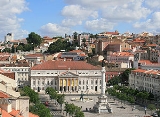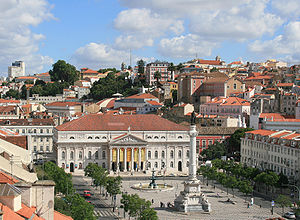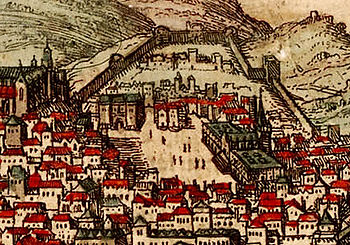
Rossio
Encyclopedia

Lisbon
Lisbon is the capital city and largest city of Portugal with a population of 545,245 within its administrative limits on a land area of . The urban area of Lisbon extends beyond the administrative city limits with a population of 3 million on an area of , making it the 9th most populous urban...
, in Portugal
Portugal
Portugal , officially the Portuguese Republic is a country situated in southwestern Europe on the Iberian Peninsula. Portugal is the westernmost country of Europe, and is bordered by the Atlantic Ocean to the West and South and by Spain to the North and East. The Atlantic archipelagos of the...
. It is located in the Pombaline Downtown
Pombaline Downtown
The Pombaline Lower Town area covers about 235,620 square metres of central Lisbon, Portugal. It comprises the grid of streets north of the Praça do Comércio, roughly between the Cais do Sodré and the Alfama district beneath the Lisbon Castle, and extends northwards towards the Rossio and...
of Lisbon and has been one of its main squares since the Middle Ages. It has been the setting of popular revolts and celebrations, bullfights and executions, and is now a preferred meeting place of Lisbon natives and tourists alike.
The current name of the Rossio pays homage
Homage
Homage is a show or demonstration of respect or dedication to someone or something, sometimes by simple declaration but often by some more oblique reference, artistic or poetic....
to Pedro IV, King of Portugal as well as first Emperor of Brasil (as Pedro I). His bronze statue is seen on top of a column in the middle of the square.
Origins
The Rossio became an important place in the city during the 13th and 14th centuries, when the population of the city expanded to the lower area surrounding the Lisbon Castle hill. The name "rossio" is roughly equivalent to the word "commons" in English, and refers to a commonly owned terrain.Around 1450, the Palace of Estaus
Estaús Palace
The Estaus Palace in Rossio Square, in Lisbon, was the headquarters of the Portuguese Inquisition. The original palace was built on the north side of the square around 1450 as lodging for foreign dignitaries and noblemen visiting Lisbon....
, destined to house foreign dignataries and noblemen visiting Lisbon, was built on the north side of the square. After the Inquisition
Inquisition
The Inquisition, Inquisitio Haereticae Pravitatis , was the "fight against heretics" by several institutions within the justice-system of the Roman Catholic Church. It started in the 12th century, with the introduction of torture in the persecution of heresy...
was installed in Lisbon, the Palace of Estaus became its seat, and the Rossio was frequently used as setting for public executions. The first auto-da-fé
Auto-da-fé
An auto-da-fé was the ritual of public penance of condemned heretics and apostates that took place when the Spanish Inquisition or the Portuguese Inquisition had decided their punishment, followed by the execution by the civil authorities of the sentences imposed...
took place in 1540.

John II of Portugal
John II , the Perfect Prince , was the thirteenth king of Portugal and the Algarves...
ordered the building of one of the most important civil and charitative infrastructures in old Lisbon, the All-Saints Royal Hospital (Hospital Real de Todos os Santos
Hospital Real de Todos os Santos
The Hospital Real de Todos os Santos was a major hospital in Lisbon, Portugal. The hospital was built between 1492 and 1504 and was destroyed in the 1755 Lisbon earthquake, along with most of the city.-Foundation:...
). The Hospital was finished in 1504, during the reign of King Manuel I
Manuel I of Portugal
Manuel I , the Fortunate , 14th king of Portugal and the Algarves was the son of Infante Ferdinand, Duke of Viseu, , by his wife, Infanta Beatrice of Portugal...
, and occupied the whole eastern side of the square. Old pictures show the façade of the Hospital to consist of a long building with an arched gallery. The portal to the chapel of the Hospital, facing the Rossio, had a magnificent façade in manueline
Manueline
The Manueline, or Portuguese late Gothic, is the sumptuous, composite Portuguese style of architectural ornamentation of the first decades of the 16th century, incorporating maritime elements and representations of the discoveries brought from the voyages of Vasco da Gama and Pedro Álvares Cabral...
style.
Near the northeastern corner of the square, actually in the neighbouring St Domingo Square, is located the Palace of the Almadas, recognisable by its early 18th century red façade. In 1640, this Palace was the meeting point of Portuguese noblemen who conspired against Spain and led to the independence of Portugal from Spanish rule
Portuguese Restoration War
Portuguese Restoration War was the name given by nineteenth-century 'romantic' historians to the war between Portugal and Spain that began with the Portuguese revolution of 1640 and ended with the Treaty of Lisbon . The revolution of 1640 ended the sixty-year period of dual monarchy in Portugal...
. The building is also called the Palace of the Independence for this reason.
The Convent of St Domingo
Dominican Order
The Order of Preachers , after the 15th century more commonly known as the Dominican Order or Dominicans, is a Catholic religious order founded by Saint Dominic and approved by Pope Honorius III on 22 December 1216 in France...
was established in the 13th century by the Rossio. Their church was greatly damaged by the 1755 Earthquake and was rebuilt in baroque style. Its façade dominates the small St Domingo square.
1755 Earthquake and rebuilding
Most buildings around the Rossio date from the reconstruction of the Pombaline DowntownPombaline Downtown
The Pombaline Lower Town area covers about 235,620 square metres of central Lisbon, Portugal. It comprises the grid of streets north of the Praça do Comércio, roughly between the Cais do Sodré and the Alfama district beneath the Lisbon Castle, and extends northwards towards the Rossio and...
carried out after the great 1755 Lisbon Earthquake
1755 Lisbon earthquake
The 1755 Lisbon earthquake, also known as the Great Lisbon Earthquake, was a megathrust earthquake that took place on Saturday 1 November 1755, at around 9:40 in the morning. The earthquake was followed by fires and a tsunami, which almost totally destroyed Lisbon in the Kingdom of Portugal, and...
, which levelled most structures in the area, including the magnificent All-Saints Hospital. Only the Palace of the Independence survived the catastrophic earthquake. The rebuilding of the Rossio was undertaken in the second half of the 18th century by architects Eugenio dos Santos and Carlos Mardel, responsible for the typical Pombaline
Pombaline style
The Pombaline style was a Portuguese architectural style of the 18th century, named after Sebastião José de Carvalho e Melo, the first Marquês de Pombal who was instrumental in reconstructing Lisbon after the earthquake of 1755. Pombal supervised the plans drawn up by the military engineers Manuel...
appearance of the buildings around the square.
From the Pombaline reconstruction dates the Bandeira Arch (Arco da Bandeira), a building at the south side of the square with a baroque
Baroque
The Baroque is a period and the style that used exaggerated motion and clear, easily interpreted detail to produce drama, tension, exuberance, and grandeur in sculpture, painting, literature, dance, and music...
pediment
Pediment
A pediment is a classical architectural element consisting of the triangular section found above the horizontal structure , typically supported by columns. The gable end of the pediment is surrounded by the cornice moulding...
and a big arch that communicates the Rossio with the Sapateiros Street. The Rossio became linked to the other main square of the city, the Praça do Comércio
Praça do Comércio
The Praça do Comércio is located in the city of Lisbon, Portugal. Situated near the Tagus river, the square is still commonly known as Terreiro do Paço , because it was the location of the Paços da Ribeira until it was destroyed by the great 1755 Lisbon Earthquake...
, by two straight streets: the Áurea and the Augusta Streets.
After a fire in 1836, the old Inquisition Palace was destroyed. Thanks to the efforts of writer Almeida Garrett
Almeida Garrett
João Baptista da Silva Leitão de Almeida Garrett, Viscount of Almeida Garrett was a Portuguese poet, playwright, novelist and politician. He is considered to be the introducer of the Romanticism in Portugal, with the epic poem Camões, based on the life of Luís de Camões...
, it was decided to build a theatre in its place. The Teatro Nacional D. Maria II, built in the 1840s, was designed by the Italian
Italy
Italy , officially the Italian Republic languages]] under the European Charter for Regional or Minority Languages. In each of these, Italy's official name is as follows:;;;;;;;;), is a unitary parliamentary republic in South-Central Europe. To the north it borders France, Switzerland, Austria and...
Fortunato Lodi in neoclassical
Neoclassical architecture
Neoclassical architecture was an architectural style produced by the neoclassical movement that began in the mid-18th century, manifested both in its details as a reaction against the Rococo style of naturalistic ornament, and in its architectural formulas as an outgrowth of some classicizing...
style. A statue of the renaissance
Renaissance
The Renaissance was a cultural movement that spanned roughly the 14th to the 17th century, beginning in Italy in the Late Middle Ages and later spreading to the rest of Europe. The term is also used more loosely to refer to the historical era, but since the changes of the Renaissance were not...
Portuguese playwright Gil Vicente
Gil Vicente
Gil Vicente , called the Trobadour, was a Portuguese playwright and poet who acted in and directed his own plays. Considered the chief dramatist of Portugal he is sometimes called the "Portuguese Plautus,"[3] often referred to as the "Father of Portuguese drama" and as one of Western literature's...
is located over the pediment
Pediment
A pediment is a classical architectural element consisting of the triangular section found above the horizontal structure , typically supported by columns. The gable end of the pediment is surrounded by the cornice moulding...
of the theatre. Ironically, some of Gil Vicente's plays had been censured by the Inquisition back in the 16th century.

Portuguese pavement
Portuguese pavement , is a traditional style pavement used for many pedestrian areas in Portugal, it can also be found in Olivenza , and throughout the old Portuguese colonies such as Brazil and Macau...
and was adorned with bronze fountains imported from France
France
The French Republic , The French Republic , The French Republic , (commonly known as France , is a unitary semi-presidential republic in Western Europe with several overseas territories and islands located on other continents and in the Indian, Pacific, and Atlantic oceans. Metropolitan France...
. The column with the statue of King Pedro IV was erected in 1874. At this time the square received its current official name, never accepted by the people.
Between 1886 and 1887 another important landmark was built in the square: the Rossio Train Station
Rossio Train Station
The Rossio Railway Station is a train station in Lisbon, Portugal, located in the Rossio square. The station was formerly known as Estação Central and that designation still appears in its façade....
(Estação de Caminhos de Ferro do Rossio). The Station was built by architect José Luís Monteiro and was an important addition to the infrastructure of the city. Its beautiful neo-manueline
Manueline
The Manueline, or Portuguese late Gothic, is the sumptuous, composite Portuguese style of architectural ornamentation of the first decades of the 16th century, incorporating maritime elements and representations of the discoveries brought from the voyages of Vasco da Gama and Pedro Álvares Cabral...
façade dominates the northwest side of the square.
Significance
The Rossio has been a meeting place for people of Lisbon for centuries. Some of the cafés and shops of the square date from the 18th century, like the Café Nicola, where poet Manuel Maria Barbosa du BocageManuel Maria Barbosa du Bocage
Manuel Maria Barbosa du Bocage was a Portuguese Neoclassic poet, writing under the pen name Elmano Sadino.-Biography:...
used to meet friends. Other traditional shops include the Pastelaria Suíça and the Ginjinha
Ginjinha
Ginjinha or simply Ginja, is a liqueur made by infusing ginja berries, in alcohol and adding sugar together with other ingredients. Ginjinha is served in a shot form with a piece of the fruit in the bottom of the cup...
, where the typical Lisbon spirit (Ginjinha
Ginjinha
Ginjinha or simply Ginja, is a liqueur made by infusing ginja berries, in alcohol and adding sugar together with other ingredients. Ginjinha is served in a shot form with a piece of the fruit in the bottom of the cup...
) can be tasted. The building of the Maria II Theatre and the Public Gardens to the north of the square only made the area more attended by Lisbon high society in the 19th century. Nowadays it is constantly populated by Lisboners and tourists.
See also
- Pombaline DowntownPombaline DowntownThe Pombaline Lower Town area covers about 235,620 square metres of central Lisbon, Portugal. It comprises the grid of streets north of the Praça do Comércio, roughly between the Cais do Sodré and the Alfama district beneath the Lisbon Castle, and extends northwards towards the Rossio and...
- Praça do ComércioPraça do ComércioThe Praça do Comércio is located in the city of Lisbon, Portugal. Situated near the Tagus river, the square is still commonly known as Terreiro do Paço , because it was the location of the Paços da Ribeira until it was destroyed by the great 1755 Lisbon Earthquake...
- Teatro Nacional D. Maria IITeatro Nacional D. Maria IIThe National Theatre D. Maria II is a theatre in Lisbon, Portugal. The historical theatre is one of the most prestigious Portuguese venues and is located in the Rossio square, in the centre of the city....
- Rossio Train StationRossio Train StationThe Rossio Railway Station is a train station in Lisbon, Portugal, located in the Rossio square. The station was formerly known as Estação Central and that designation still appears in its façade....
- Hospital Real de Todos os SantosHospital Real de Todos os SantosThe Hospital Real de Todos os Santos was a major hospital in Lisbon, Portugal. The hospital was built between 1492 and 1504 and was destroyed in the 1755 Lisbon earthquake, along with most of the city.-Foundation:...
- Estaus PalaceEstaús PalaceThe Estaus Palace in Rossio Square, in Lisbon, was the headquarters of the Portuguese Inquisition. The original palace was built on the north side of the square around 1450 as lodging for foreign dignitaries and noblemen visiting Lisbon....

